BLOG POSTS ARE PRELIMINARY MATERIALS CIRCULATED TO STIMULATE DISCUSSION AND CRITICAL COMMENT. THE VIEWS EXPRESSED ARE THOSE OF THE INDIVIDUAL AUTHORS. WHILE BLOG POSTS BENEFIT FROM ACTIVE UHERO DISCUSSION, THEY HAVE NOT UNDERGONE FORMAL ACADEMIC PEER REVIEW.
By Tim Halliday and Rachel Inafuku
Across the nation, the cost of higher education has significantly increased over the past 20 years [1]. The surge in tuition prompted the Biden Administration’s plan to forgive $39 billion in student loan debt for approximately 800,000 borrowers. The ongoing concerns regarding college affordability have led many to question the value of a college degree as an investment. According to a survey conducted by the Wall Street Journal/NORC Polling Partnership, Americans are increasingly losing faith in higher education. In 2023, 56% of survey respondents believed that college was not worth the cost, compared to just 40% of respondents in 2013 [2].
Contrary to national trends, college tuition within the University of Hawai`i (UH) system has become more affordable for Hawai`i’s residents over the past ten years after adjusting for inflation. In 2022 dollars, in-state tuition for the 2023-2024 academic year at UH Mānoa was $11,035, roughly three hundred dollars less than the tuition for the 2013-2014 school year. Similarly, tuition across all other UH college campuses has also experienced a slight decrease over the same time period.
University of Hawai`i in-state tuition by campus (in 2022 dollars)
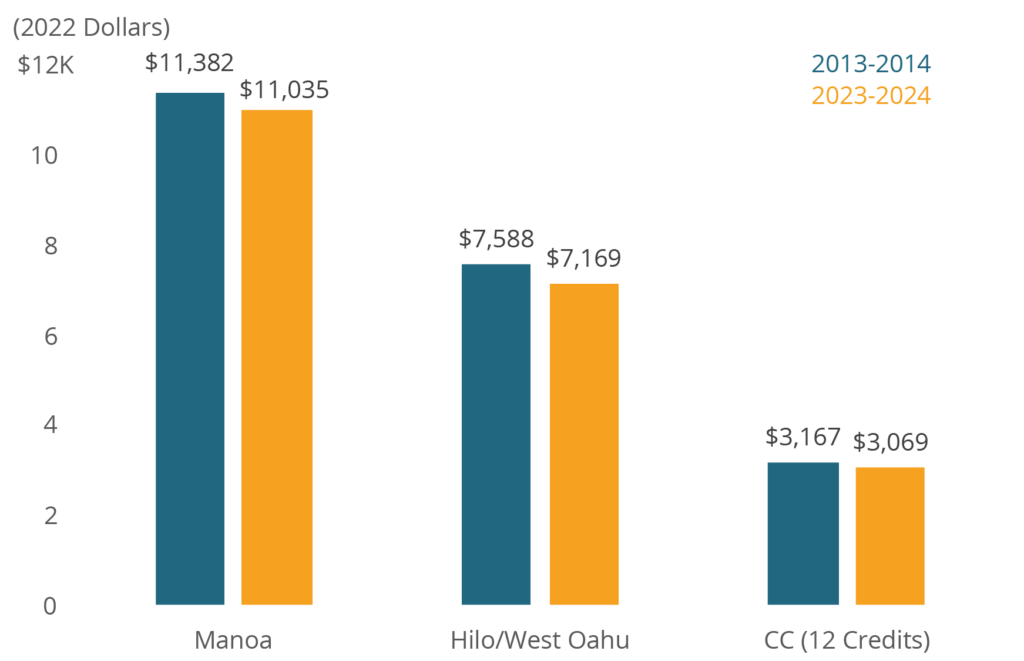
Inflation-adjusted tuition at University of Hawai`i campuses has become more affordable over the last decade
Despite the decrease in inflation-adjusted tuition across all UH campuses over the past decade, college enrollment among Hawai`i’s public school graduates has not increased in comparison to the national level. Historically, Hawaii’s public school graduates have entered college at a notably lower rate compared to the US average. In 2019, the college enrollment rate was 55%, compared to the national rate of 66%. Following national trends, the COVID-19 pandemic resulted in a decrease in college enrollment, leading to a 50% enrollment rate for Hawaii’s public school graduates. This figure has yet to recover to its pre-pandemic level. This represents approximately 500 fewer public high school graduates entering college per year.
Hawai`i public school college enrollment rate by year
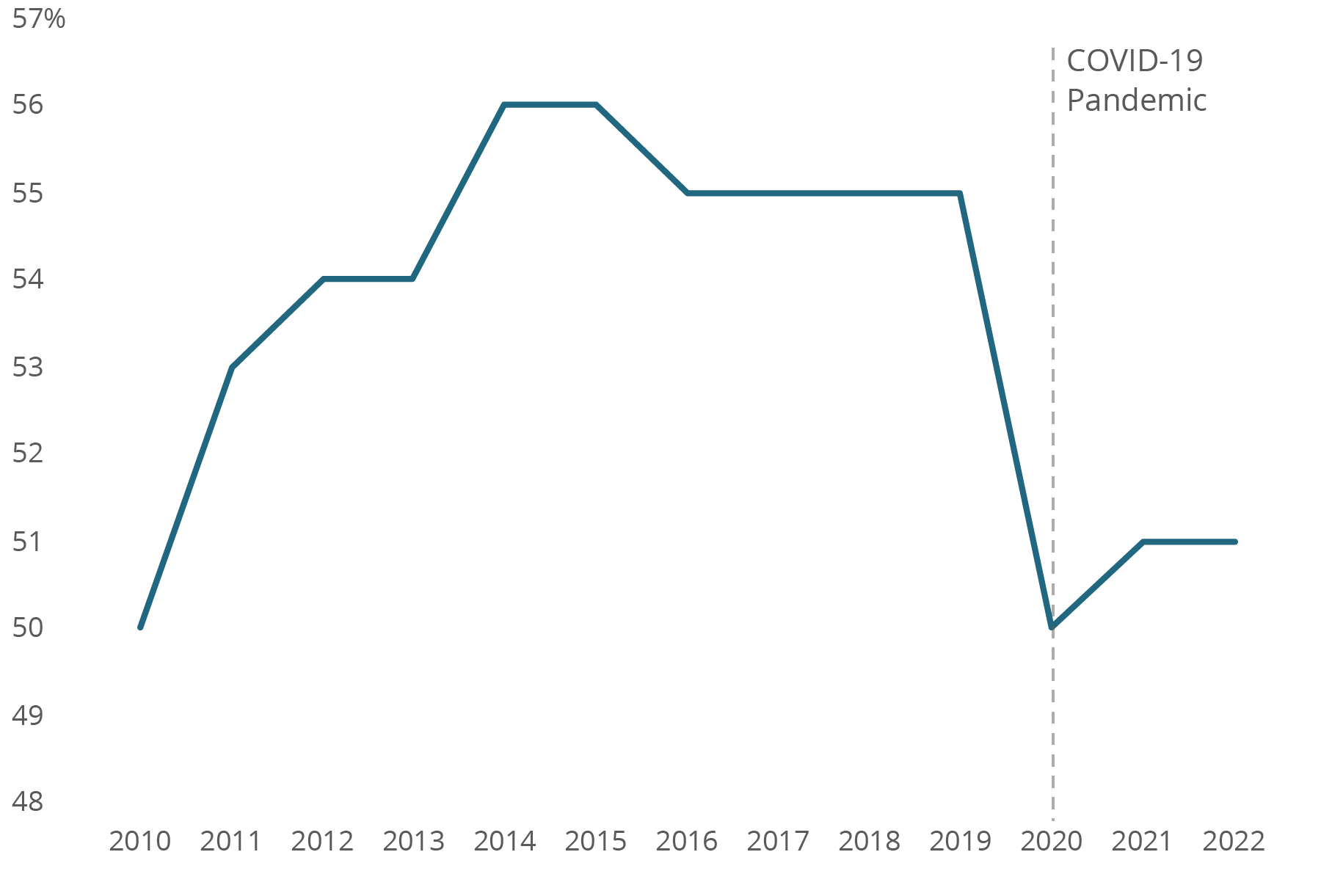

College enrollment has yet to return to its pre-pandemic level for Hawai`i’s public school graduates
Utilizing data from the Hawai`i Data eXchange Partnership, a UHERO report estimated the value of different degrees—certificates, AA degrees, AS/AAS degrees, and bachelor’s degrees—from the UH system. The study revealed that, on average across all degree types, college graduates earned 11 to 13% more than individuals with similar demographic characteristics who dropped out of their programs of study five to nine years after graduation. Examining the returns to higher education by degree program, the study highlighted that, except for AA degree graduates, all other degree holders earned more in the long run than individuals who dropped out of their respective programs. Nine years after graduation, those with an AS/AAS degree, certificate, and bachelor’s degree out-earned dropouts by 10%, 33%, and 30%, respectively.
Earnings for college graduates relative to program leavers by degree program
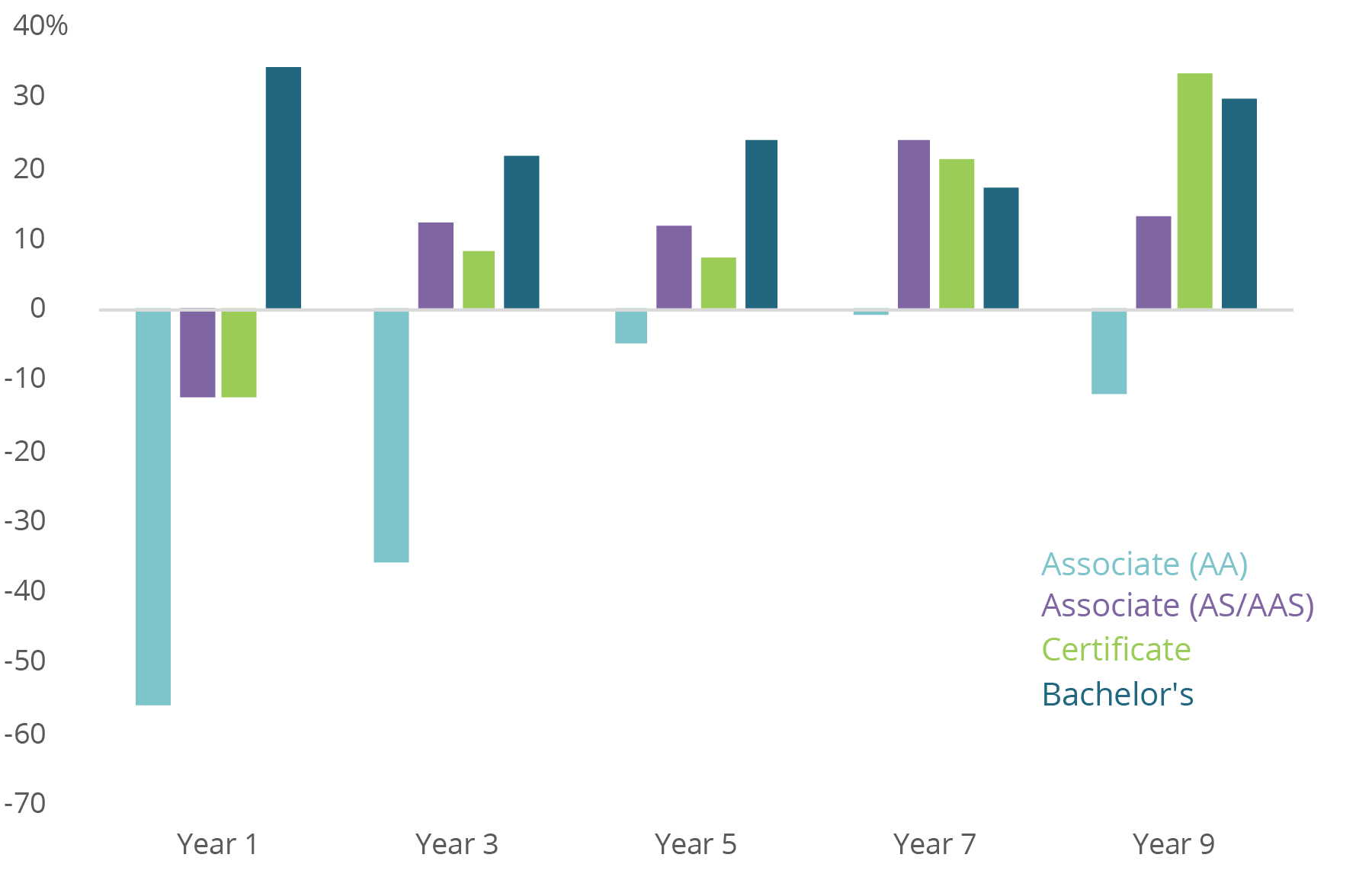

Bachelor’s degree, AS/AAS degree, and Certificate holders outearn their college dropout counterparts in the long run.
The study explored how a college degree offsets the impact of lower socioeconomic status. Utilizing Pell Grants as a measure of economic disadvantage, the research revealed that individuals from economically disadvantaged backgrounds encounter added challenges in the labor market, leading to lower wages compared to those from more affluent households. However, completing college mitigates this effect. Five years after graduating, degree holders with Pell Grants earn 5% more than non-degree holders from wealthier households. By the ninth year post-graduation, the wage advantage for Pell Grant recipients with college degrees matches that of degree holders from wealthier households. This finding implies that college completion mitigates and perhaps diminishes the intergenerational transmission of lower socioeconomic status.
Earnings projections for graduates and non-graduates further highlight the added value of a college degree. By age 30, individuals who obtained a certificate from a UH community college earned an average of $48,000, whereas those who left the certificate program earned $44,000. The earnings gap between graduates and non-graduates was substantial for those in the AS/AAS and bachelor’s degree programs. At age 30, those with an AS/AAS degree earned an average of $52,000, contrasting with program leavers who earned $44,000. Bachelor’s degree holders earned $54,000, while those who dropped out of the program earned $43,000.
Interestingly, those who obtained an AA degree earned slightly less than those who exited the program early. There are a couple mechanisms that explain this disparity. First, unlike those who get an associate degree in a science field (AS/AAS), AA degrees are seen as a stepping stone towards a bachelorʻs degree and are not highly rewarded on their own in the labor market. Moreover, those with an AA tend to select careers that pay less on average than those who drop out of the program and vice versa. For example, there are six times as many AA program leavers working in the construction industry, which tends to pay higher, than AA graduates. Conversely, 13% of AA graduates work in lower paying education services occupations compared to just 3% of program dropouts.
Earnings at age 30 by degree program
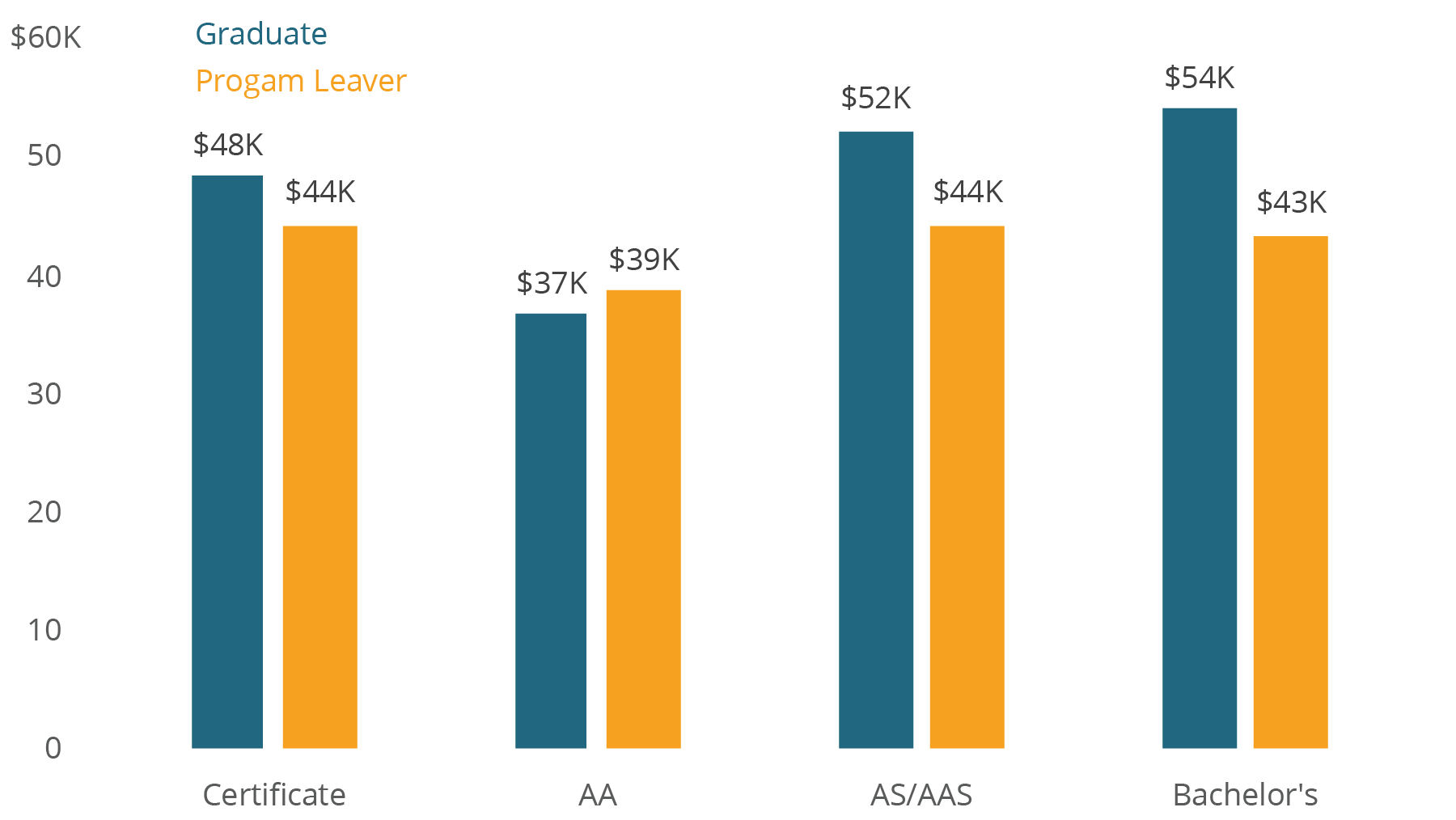

Degree holders tend to outearn program dropouts at age 30
The study also projected lifetime earnings for associate degree and bachelorʻs degree holders. Over the course of a lifetime, bachelorʻs degree holders earn $2.8 million, which is 27% higher than those who dropped out of the program. AS/AAS degree graduates earn nearly as much as those with a bachelorʻs degree at $2.7 million, earning 22% more than program leavers. Lifetime earnings for AA degree holders were smaller at $1.9 million.
Llifetime earnings projections
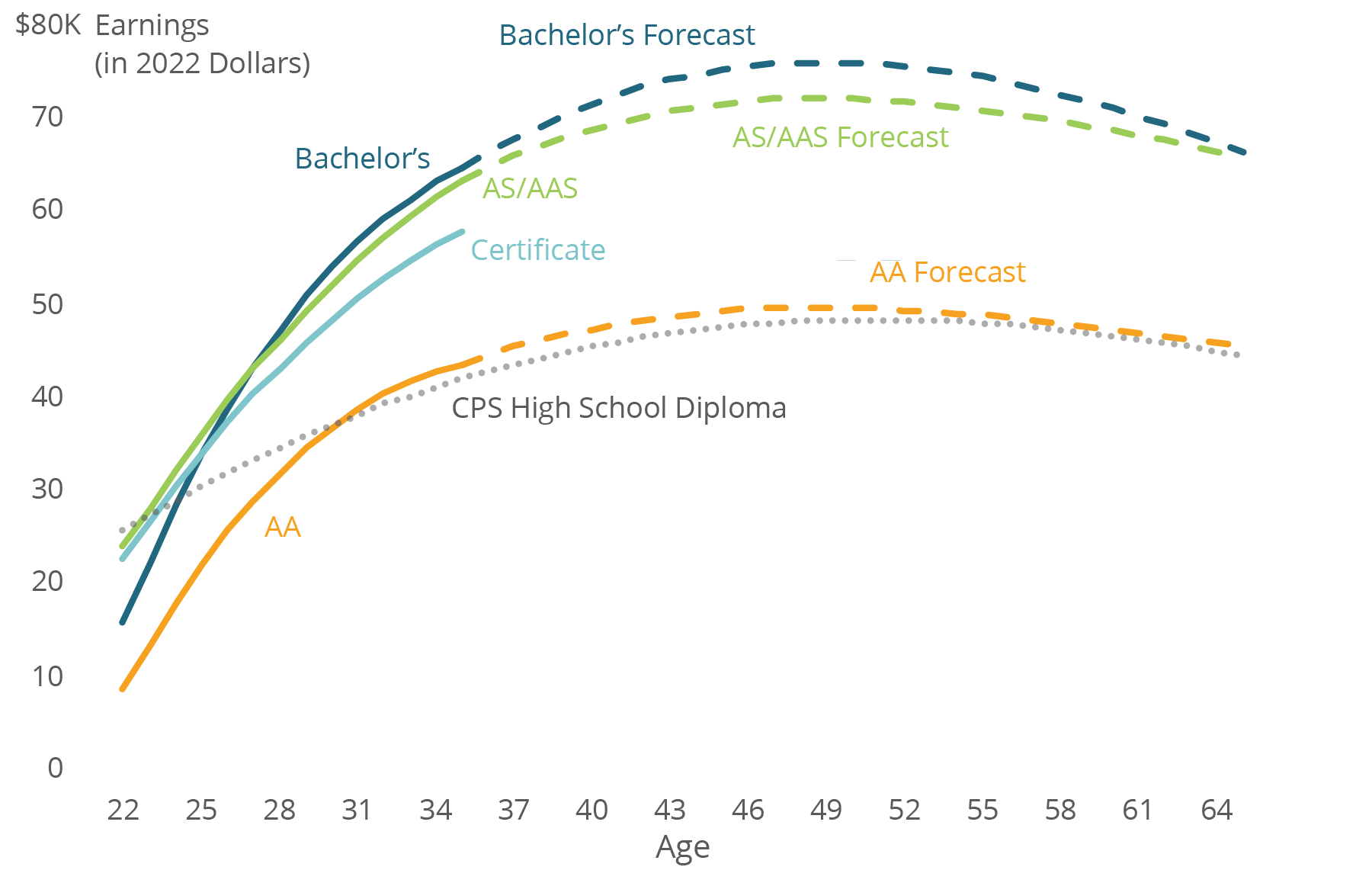

Bachelorʻs degrees and AS/AAS degrees significantly increase lifetime earnings
Note: Data on earnings comes from the Hawaii Data eXchange Partnership. Forecasted earnings are estimated using data from the Current Population Survey. The CPS High School Diploma Average is based on data from the Current Population Survey. Due to a lack of data availability, lifetime earnings for certificate holders cannot be calculated.
While college completion is associated with higher earnings, this does not take into account the cost of higher education. Not only are there financial expenses associated with college, but also opportunity costs since most students forgo earning income at a full time job to attend college. Taking these costs into account, the UHERO study estimates internal rates of return (IRR) based on the net benefits of a college education. In this context, the IRR estimates the average annual rate of return to a college degree in which the return is labor earnings and the investment costs are tuition, student loans, and income students could be earning had they not enrolled in college. Even after factoring in these three costs, the returns to a college degree are still large. The lifetime IRR for an AS/AAS degree and bachelorʻs degree is 18% and 13% respectively. Although the study does not estimate a lifetime IRR for certificates, the fifteen-year IRR is 13%.
While AA degrees alone are not highly rewarded in the labor market, when used as a stepping stone to a bachelorʻs degree, the lifetime IRR is large. For those who obtain an AA degree and transfer to a 4-year university within the UH system, the low cost of the AA degree credits coupled with the high earnings potential of a bachelorʻs degree leads to a 19% lifetime IRR for these bachelorʻs degree holders.
Table 1: Internal Rate of Return (IRR) by Degree Type
| 15 Year IRR | Lifetime IRR | |
| Professional Certificate | 13.26% | N/A |
| Associate Degree (AA) | N/A | N/A |
| Associate Degree (AS/AAS) | 14.35% | 17.81% |
| Bachelor’s Degree | 5.61% | 12.96% |
| AA transfer to Bachelor’s Degree | 14.91% | 18.90% |
Taken together, a college degree has the ability to greatly improve oneʻs quality of life. Because of the many financial benefits to a degree, this report suggests that on average, college degrees from the UH system are well worth their cost for residents. Not only does obtaining a college degree propel graduates ahead of those without a degree, but it is also an engine of upward social mobility, builds human capital, and increases lifetime earnings. As such, lower college enrollment rates among Hawai`i’s DOE high school graduates are a major concern in the State of Hawai`i. Increasing the college readiness of Hawai’i’s young adults and promoting college enrollment should be a top priority for the state’s policymakers.
[1] https://www.usnews.com/education/best-colleges/paying-for-college/articles/see-20-years-of-tuition-growth-at-national-universities
[2] https://www.wsj.com/articles/americans-are-losing-faith-in-college-education-wsj-norc-poll-finds-3a836ce1



